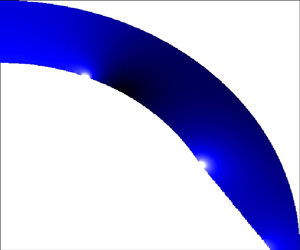Article contents
Analytical solution of flows in porous media for transpiration cooling applications
Published online by Cambridge University Press: 11 March 2021
Abstract

This paper presents closed analytical solutions for the pressure and velocity fields of flows in two-dimensional porous media. The flow field is modelled through a potential function which allows the use of the Laplace equation to describe the pressure field. The boundary conditions of the porous medium are tailored to represent general cases encountered in transpiration cooling applications. These include mixed Neumann and Dirichlet boundary conditions to represent a pressurised plenum driving a coolant mass flux, and impermeable sections where the plenum is attached to a non-porous substructure. The external pressure boundary is modelled as an arbitrary function representing a flow around the porous domain, and the wall thickness of the porous domain can take any arbitrary distribution. General solutions in Cartesian coordinates and cylindrical coordinates are provided describing the entire porous domain of a flat plate or curved geometry, respectively. In addition, special simplified solutions are provided for regions of particular interest, such as the interface of external flow and porous medium. The obtained solutions are verified through a comparison to a numerical simulation of two test cases, a rectangular flat plate geometry and 90 $^\circ$ section of a cylindrical case.
$^\circ$ section of a cylindrical case.
- Type
- JFM Papers
- Information
- Copyright
- © The Author(s), 2021. Published by Cambridge University Press
References
REFERENCES
- 4
- Cited by





